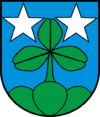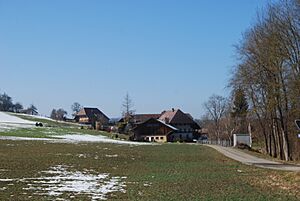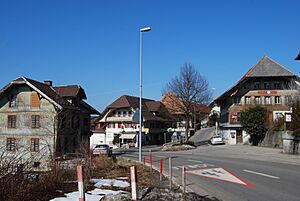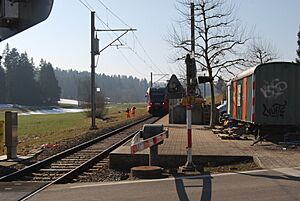Gondiswil facts for kids
Quick facts for kids
Gondiswil
|
||
|---|---|---|
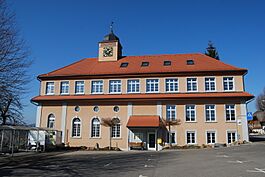
Reformed church, post office and town hall of Gondiswil
|
||
|
||
| Country | Switzerland | |
| Canton | Bern | |
| District | Oberaargau | |
| Area | ||
| • Total | 9.4 km2 (3.6 sq mi) | |
| Elevation | 660 m (2,170 ft) | |
| Population
(Dec 2020 )
|
||
| • Total | 711 | |
| • Density | 75.6/km2 (195.9/sq mi) | |
| Postal code |
4955
|
|
| Surrounded by | Huttwil, Auswil, Madiswil, Reisiswil, Melchnau, Grossdietwil, Fischbach, Zell and Ufhusen. | |
Gondiswil (called Gumiswil by locals) is a municipality in Switzerland. It is located in the Oberaargau area of the Bern canton. A canton is like a state or province in other countries.
Contents
History of Gondiswil
Gondiswil was first mentioned in old writings around the mid-800s. It was called Cundolteswilare back then.
Long ago, some tools from the neolithic (New Stone Age) were found here. This shows people lived in the area a very long time ago. During the Middle Ages, important families owned most of the land. Over time, different religious groups, like St. Urban's Abbey and the Knights Hospitaller, also gained land.
Gondiswil became part of Bern in the late 1400s. Under Bern's rule, Gondiswil and Melchnau shared a local court. This court handled smaller legal matters.
Religious Changes Over Time
For a long time, Gondiswil was part of a church parish in Grossdietwil. But after the Protestant Reformation in 1528, it joined the Melchnau parish. A parish is a church district with its own church and priest.
Gondiswil wanted its own parish. So, in 1737, the village built a cemetery. This was a step towards having their own church. Services began in the village in the mid-1800s. A church was finally finished in 1918. In 1945, a vicar (a type of priest) was assigned to Gondiswil. Finally, in 1960, Gondiswil became its own parish with a rectory (a house for the priest).
There was also a chapel called St. Mary's Chapel in a small area called Freibach. It was built around 1300. This chapel became a popular place for pilgrimages (religious journeys). It was also a meeting place for local blacksmiths. The chapel was taken down in 1528.
Economy and Transportation History
In the 1700s and 1800s, people in Gondiswil worked in linen mills and a wooden shoe factory. These jobs were in addition to farming. In 1889, a railway line was built through Gondiswil. A train station was also built, connecting the village to other towns.
During the First and Second World Wars, there was a coal mine in Gondiswil. This helped provide energy during those times.
Geography of Gondiswil
Gondiswil covers an area of about 9.4 square kilometers (3.6 square miles). A large part of this land, about 69.3%, is used for farming. This includes fields for crops and pastures for animals.
About 24.3% of the land is covered by forests. The remaining land is used for buildings and roads (5.9%). A very small part (0.3%) is rivers or lakes.
Gondiswil is located right on the border of the Canton of Lucerne. The municipality includes the main village of Gondiswil. It also has several smaller settlements called hamlets. These hamlets are Freibach, Brüggenweid, Haltstelle, Staldershaus, and Schwendi.
Coat of Arms
The coat of arms for Gondiswil is blue. It shows a green three-leaf clover growing from three green hills. Above the clover, there are two silver five-pointed stars.
Population and People
Gondiswil has a population of about 700 people. A small number of people, about 2%, are foreign nationals. Most people in Gondiswil speak German as their first language. A smaller number speak Albanian or English.
In 2008, slightly more than half of the population was male (51%). The rest were female (49%). Most people living in Gondiswil were born there or in the same canton.
About 20.8% of the population are children and teenagers (0–19 years old). Adults (20–64 years old) make up 58% of the population. Seniors (over 64 years old) make up 21.1%.
Most homes in Gondiswil are permanently lived in. Only a small number are empty or used only part of the year.
The chart below shows how the population of Gondiswil has changed over many years:

Transportation in Gondiswil
Gondiswil has its own train station. It is on the railway line that connects Wolhusen and Huttwil. This makes it easy for people to travel to and from the village.
Economy and Jobs
In 2011, Gondiswil had a very low unemployment rate of 0.44%. This means almost everyone who wanted a job had one.
Most jobs in Gondiswil are in the primary economic sector. This means jobs related to farming. There are also jobs in the secondary sector, like manufacturing and construction. A smaller number of jobs are in the tertiary sector. This includes jobs in sales, hotels, restaurants, and education.
Many people who live in Gondiswil travel to other towns for work. About 7% of workers use public transportation. Most, about 58.2%, use a private car to get to work.
Religion in Gondiswil
Based on a 2000 survey, most people in Gondiswil belong to the Swiss Reformed Church (about 87.9%). A smaller number are Roman Catholic (5.4%).
There are also a few people who belong to other Christian churches. Some people are Islamic. About 2.45% of the population do not belong to any church. These people might be agnostic (not sure if God exists) or atheist (do not believe in God).
Education in Gondiswil
In Gondiswil, many people have completed upper secondary education. This is like high school. Some have also gone on to higher education, like university.
The school system in the Canton of Bern starts with one year of optional Kindergarten. After that, students go to six years of primary school. Then, they have three years of lower secondary school. In secondary school, students are grouped by their abilities. After lower secondary, students can choose to continue their education or start an apprenticeship (learning a trade on the job).
In the 2009–10 school year, 67 students attended schools in Gondiswil. There were no kindergarten classes in the village. There were 3 primary classes with 52 students. There was also one lower secondary class with 15 students.
Some students who live in Gondiswil go to school in other towns. Also, some students from other towns come to school in Gondiswil.
See also
 In Spanish: Gondiswil para niños
In Spanish: Gondiswil para niños


